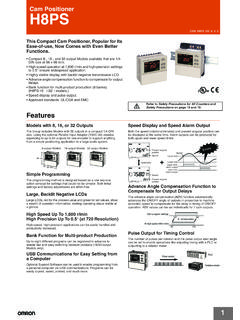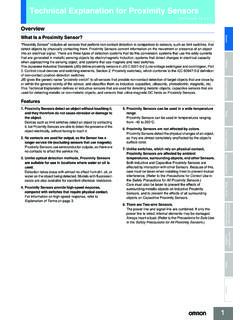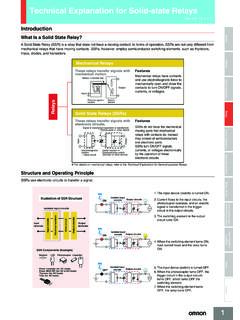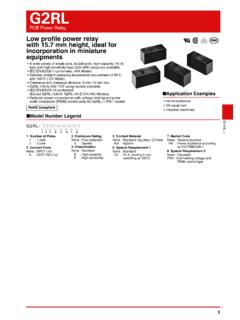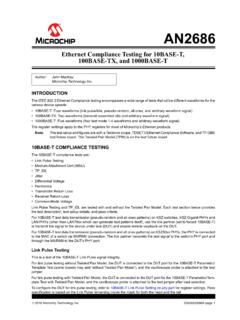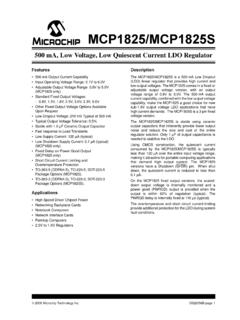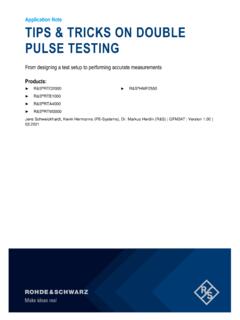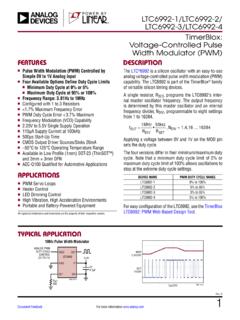Transcription of Servo Motor Selection Flow Chart - Omron
1 Servo Motor Selection Flow Chart START Selection Explanation References Determine the size, mass, coefficient of Has the machine friction, and external forces of all the moving NO. Been Selected? part of the Servo Motor the rotation of which affects. --- YES. Determine the operating pattern (relationship Operation Pattern Formula Has the Operating between time and speed) of each part that NO. Pattern Been Selected? must be controlled. Convert the operating pattern of each controlled element into the Motor shaft YES. operating pattern. Calculating the load Inertia For The elements of the machine can be Inertia Formulas Motor Shaft Conversion Value separated so that inertia can be calculated for each part that moves as the Servo Motor rotates.
2 Calculate the inertia applied to each element Calculating the Added load to calculate the total load inertia of the Motor Torque For Motor Shaft shaft conversion value. Conversion Value Calculation of Friction Torque load Torque Formulas Calculates the frictional force for each element, where necessary, and converts it to friction torque for a Motor shaft. Calculation of External Torque Calculates the external force for each Select a Motor temporarily element, where necessary, and converts it to external torque of a Motor shaft. Calculates the total load torque for the Motor Calculate Acceleration/ shaft conversion value. Deceleration Torque Select a Motor temporarily based upon the Motor shaft converted load inertia, friction --- torque, external torque and of a Motor .
3 Confirm Maximum Momentary Torque and Calculate the Acceleration/Deceleration Acceleration/Deceleration Calculate Effective Torque Torque from the load Inertia or Operating Torque Formulas Pattern. Calculate the necessary torque for each part Calculation of Maximum of the Operating Pattern from the Friction Momentary Torque, Effective Torque, External Torque and Acceleration/ Torque Deceleration Torque. Confirm that the maximum value for the Torque for each operating part (Maximum 2 1 Momentary Torque) is less than the Maximum Momentary Torque of the Motor . Calculate the Effective Torque from the Torque for each Operating part, and confirm that it is less than the Rated Torque for the Motor .
4 3. 2 1. Explanation References Calculate Regenerative Energy Calculate Regenerative Energy from the Please see the user manual Torque of all the moving parts. of each product for the details on calculation of the regenerative energy. Check if the the number of encoder pulses Accuracy of Positioning NO Is the Resolution meets the system specified resolution. OK? YES. Check if the calculation meets the The following table specifications of the temporarily selected NO Are the Check Items Motor . on Characteristics All OK? If not, change the temporarily selected Motor and re-calculate it. YES. Specialized Check Items Check Items load Inertia load Inertia Motor Rotor Inertia x Applicable Inertia Ratio Effective Torque < Motor Rated Torque Effective Torque Please allow a margin of about 20%.
5 *. Maximum Momentary Torque < Motor Maximum Momentary Torque Maximum Please allow a margin of about 20%. *. Momentary Torque For the Motor Maximum Momentary Torque, use the value that is combined with a driver and the one of the Motor itself. Maximum Rotation Speed Rated Rotation Speed of a Motor Try to get as close to the Motor 's rated rotations as Maximum Rotation possible. It will increase the operating efficiency of a Speed Motor . For the formula, please see "Straight-line Speed and Motor Rotation Speed" on Page 11. Regenerative Energy Regenerative Energy Absorption of a Motor Regenerative When the Regenerative Energy is large, connect a Energy Regenerative Energy Absorption Resistance to increase the Absorption capacity of the driver.
6 Ensure that the Encoder Resolution meets the system Encoder Resolution specifications. END Selection Check if the pulse Frequency does not exceed the Characteristics of a Maximum Response Frequency or Maximum Command Positioner Frequency of a Positioner. Ensure that values of the ambient operating temperature/. Operating humidity, operating atmosphere, shock and vibrations Conditions meet the product specifications. * When handling vertical loads and a load affected by the external torque, allow for about 30% of capacity. 4. Formulas Formulas for Operating Patterns speed v0 Maximum Speed X0. v0 = X0: Distance Moved in t0 Time (mm). tA. v0: Maximum Speed (mm/s).
7 Triangular Acceleration/Deceleration Time X0. tA = t0: Positioning Time (s). v0. tA: Acceleration/. Deceleration Time (s). tA tA time Travel Distance X0 = v0 tA. t0. X0. Maximum Speed X0. speed v0 =. t0 tA. v0 Acceleration/Deceleration Time tA = t0 X0. v0. Total Travel Time t0 = tA + X0. v0. Trapezoid Constant-velocity travel time tB = t0 2 tA = 2 2 X0 t0 = X0 tA. v0 v0. time tA tB tA Total Travel Distance X0 = v0 (t0 tA). t0. Acceleration/Deceleration Travel Distance XA = v0 tA = v0 t0 X0. XA XB XA 2 2. X0 Constant-velocity travel distance XB = v0 tB = 2 X0 v0 t0. speed Ascending Time tA = v0 v1.. v0. Ascending Time (tA) including distance moved v1.
8 1. Speed and Slope vg XA = tA2 + v1 tA. When Ascending 2. 2. time 1 (v0 v1). XA = + v1 tA. tg tA 2 . Speed after Ascending v0 = v1 + tA. vg Speed Gradient tg 5. Conditions for Trapezoidal Operating Pattern speed v0. t02 . X0 <. 4. X0: Positioning Distance (mm). Maximum Speed Speed and Slope t0: Positioning Time (s). Trapezoid pattern t0 4X0 tA: Acceleration/Deceleration v0 = (1 1 ) Time (s). 2 t0 . v0: Maximum Speed (mm/s). time tA tA Ascending Time : Speed Gradient t0 v0 t 4X0. tA = = 0 (1 1 ). 2 t0 . speed Conditions for Triangular Operating Pattern v0. t02 . X0 . 4. Maximum Speed Speed and Slope Triangular Pattern v0 = X0. tA tA time Ascending Time t0 X0.
9 TA =.. X0. v [mm/s]. Linear Movement Perform the following unitary conversions X. [mm] Linear Movement Rotating Movement X: Distance (mm) : Angle (rad). Rotating Part v: Speed (mm/s) : Angular Velocity (rad/s). [rad]. 2 N. =. 60. N: Rotating Speed (r/min). [rad/s]. N [r/min]. 6. Inertia Formulas D2: Cylinder Inner Diameter (mm). D1: Cylinder Outer Diameter (mm). 2 2. Cylindrical Inertia JW = M (D1 + D2 ) 10 6 (kg m2). 8. M: Cylinder Mass (kg). JW: Cylinder Inertia (kg m2). M: Cylinder Mass (kg). M. Eccentric Disc C JW: Inertia Inertia (Cylinder (kg m2). which rotates off JC: Inertia around the JW = JC + M re2 10 6 (kg m2). the center axis) center axis of Cylinder re: Rotational Radius (mm).
10 Center of rotation M: Square Cylinder Mass (kg). M b: Height (mm). Inertia of Rotating 2 2. Square Cylinder JW = M (a + b ) 10 6 (kg m2). 12. JW: Inertia (kg m2). a: Width (mm). L: Length (mm). M: load Mass (kg). Inertia of Linear 2. Movement JB: Ball Screw Inertia (kg m2). JW = M ( 2 P ) 10. 6. + JB (kg m2). P: Ball Screw Pitch (mm). JW: Inertia (kg m2). D: Diameter (mm). JW M1: Mass of Cylinder (kg). J1: Cylinder Inertia (kg m2) JW = J1 + J2. Inertia of Lifting D2 M2 D2. = M1. ( ). 2. Object by Pulley J2: Inertia due to the Object (kg m ) + 10 6 (kg m2). 8 4. M2: Mass of Object (kg). JW: Inertia (kg m2). 7. M. Rack Inertia of Rack and M D2.
